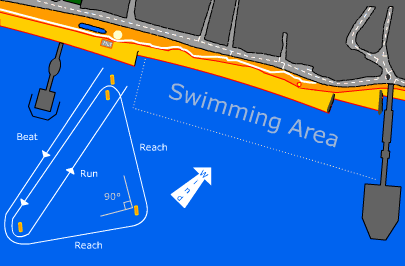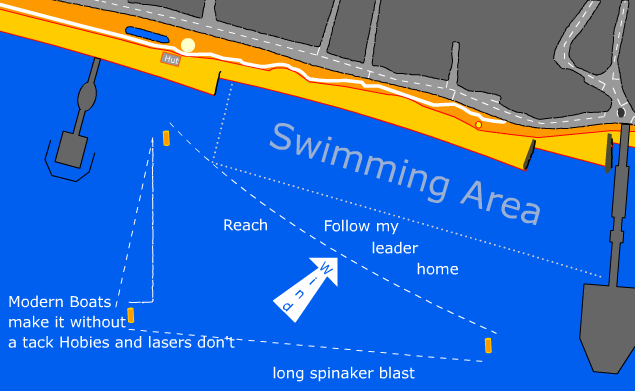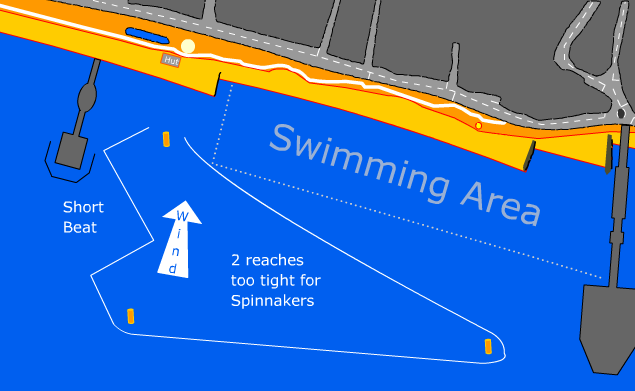Why Dinghy Courses Matter
The position you come in a race is subject to several factors, 2 similar, I.E. same class boats finishing position is a function of: 
- Order at the start - who got away first has an advantage.
- Boat handling - Especially in a Hobie, good tacks are very important.
- Tactics - More wind correct tide and positioning against other boats.
The condition of you boat, and the top speed you can sail it come into it too, but are unimportant compared to the above. You note last years Brighton SC cat winner has a very dilapidated and patched 16.
Passing is also an issue. A competent helm can prevent even a slightly faster class overtaking him on a reach, keep up to stop them going above you and bear off on them to nick their wind if they're dumb enough to go go underneath and you can hold your position for ever.
No two boats of the same class should never swap places on a reach, so if we just raced to the marina (in Brighton our shore runs east west, with the marina to the east) in a southerly, then who ever starts first wins (assuming there's no massive difference in skill). The Race is over before it begins. This why they say a course should always have one of sort of each leg. E.G. the "Olympic Course" above.
Upwind is a different matter, for starters windward legs are longer. Longer in time not distance. If we raced to the marina in an easterly. It would take twice as long as the reach did, as we'd have to tack and sail slower. Races are won and lost on windward and Leeward legs. Considered the easterly marina race on an incoming tide, boat A starts on port tack heading out to sea, boat B, with brand new sails, carbon tiller extension etc. Heads off on starboard, towards the beach. Boat B has less tide pushing him along, his wind is disrupted by the Palace Pier. Bad choice and it gets worse, boat A can go right out to sea, tack once, and go to the marina "banging the corners". Boat be will have to tack twice, and if by some miracle he manages to keep up with boat A, boat a will approach the marina mark on Starboard and barge him out. You can't just block overtaking boats, there are plenty of opportunities to pass.This race is on!
Downwind is similar, boat A decides, he was just lucky offshore. Heads off out to sea again on the way back to the club. Boat B goes inshore out of the tide and into the flatter water, we've got real race this time. I don't know which would win. More wind and more tide versus, less wind and less tide. Get this wrong and you'll know about it, and again its not easy to block.
Lets throw in different classes. (I know I'm prejudiced, but bear with me). The modern boats, the tigers RS and I14, can point higher than the older classes such as lasers and Hobies and handle better. They also have spinnakers which allow them primarily to run deeper downwind with out slowing. Broadly speaking spinnakers can only be used on very board reaches (if there's any sort of breeze). So if we revisit example one, the long reach. The Hobie cat we know its hot on a reach, the RS and the Tiger's have to leave there kites down. Their handicap includes these sails for part of time. The lasers and 16, should have a field day.
On the example of an easterly, windward only course we should be closer matched, windward takes longer and therefore makes up for more of the handicap (theoretically). Also the course's long and doesn't require lots of maneuvers, the fact that the Hobies cam make a few long tacks compensate for the pointing ability of the modern boats. I wouldn't like to call this one. A short course and I'll shift money on to the better handling boats.
Down wind's another story, the modern boats can gybe fast and run deep out of the tide and take the 16's to the cleaners. However spinnaker hoist and drops cost time, a lot, unless you've got a good sharpender. Make this a short leeward leg and the advantage goes back the other way, the laser's and 16 sail off while the tiger's are trying to hoist and drop.
Have you ever watched the WRC rally coverage's "Virtual Spectator"? Its where they record the cars speeds and superimpose them on the same bit of road, so you can see what they perform like against each other. If we do Tom's "mental spectator", on Simon and Roger, 2 equally skilled sailors, with equal age sails, equal luck and identical tack ticks in different classes. We have Tom's "mental spectator" running the handicaps against them in our head. and send them around a triangle and sausage. They start equal, as they head off up the beat Roger's 16's lead on handicap increases, till they tack. Roger drops back as the tack takes ages, however he claws back till they're equal at the top mark. Ok they both bear off perfectly onto the reach, Simon's RS drops back on virtual corrected time as he's got no kite and the 16's ballistic reaching kicks in. He catches up a little at the gybe mark, the 16's gybe takes a long time but he's still loosing out all the way to the start mark. The beats the same as before, Roger holds the lead he got on the reach. When they round the windward mark on a sausage Its a very different story. His lead leaps up for 10 seconds as Penny Hoists the kite, the RS then eats massively into his lead, the gybes are similar this time, because the rs has to gybe the Kite. However Simon keeps reeling Roger in all the way to the finish, where they finish exactly the same on corrected time.Ok that's how its supposed to work., however chose a course with the wrong balance of legs and you decide the race before it starts.
In summary short courses benefit boats with good boat handling, and no spinnakers. Long courses benefit the older classes, and spinnaker boats. Beats are pretty even, but tactically important. Reaches benefit Hobies and Lasers on handicap but are meaningless for individual fleets. Runs benefit spinnaker boats and good tacticians.
How to really wreck a race.
The worst course for good competition is what we get a lot of. The Rescue boat drops a bouy by the hut another out to sea. And one out towards Palace Pier. Because of perspective the windward mark isn't far out to sea, where as the one towards Palace Pier is miles away and the course is a squashed triangle. One of two things happen:
Either

The windward leg is not really windward, and Simon me and Steve sail straight up it while the others have to tack, we bear off towards the Pier, because the beat wasn't a beat and the triangle's elongated the wrong way, we blast off under kites. Gybe at Palace Pier, and form line astern practically close hauled back to the start mark. Crucifying every one on handicap.
Or

The windward leg is a proper beat, but the triangle so elongated that the reaches are too tight for spinnakers and the 16's and lasers slaughter the modern designs.
To quote Kevin B****Y Wilson "It was over before it began"